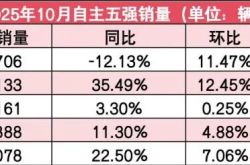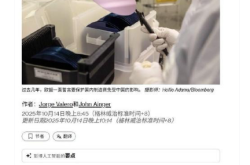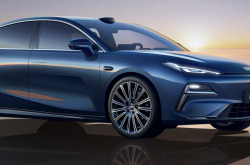Robotaxi News Intensifies: Who Will Lead the Mass Production Race?
![]() 05/29 2025
05/29 2025
![]() 754
754
By 2025, the Robotaxi sector is abuzz with anticipation. Both Western and Eastern players are sprinting towards commercialization, igniting another high-stakes "race." In recent years, we've witnessed similar races in large models, robots, and semiconductors. Now, it's the Robotaxi's turn to shine.
Recently, Musk clarified in an interview with CNBC that Tesla's Robotaxi will hit the roads by the end of June. Waymo, on the other hand, has chosen to collaborate with Uber to accelerate the commercialization of Robotaxi, officially announcing plans to double the production capacity of Robotaxi at its Arizona factory next year.
In China, the L4 models jointly developed by Didi and GAC Aion are set for mass production and delivery by the end of the year. Momenta has partnered with SAIC, aiming to operate hundreds of vehicles by 2026. Pony.ai, which went public last year, just released its first-quarter report, revealing a surge of about 800% in passenger fares for its core Robotaxi business. The seventh-generation Robotaxi will enter mass production in the second quarter, with an expected fleet size of 1,000 vehicles by the end of the year.
At first glance, both sides may need another one to two years to truly transform. However, much like the groundbreaking DeepMind moment earlier this year, when we reflect on the Robotaxi industry's development trajectory, we might conclude in advance: This time, it will be Chinese Robotaxi enterprises that seize the initiative.
In this burgeoning market, a "butterfly" is flapping its wings, heralding a storm.
From Technology Verification to Large-Scale Deployment: A Milestone for Robotaxi
Frost & Sullivan predicts that the global Robotaxi market size will grow from $290 million in 2025 to $66.6 billion in 2030, with China becoming the largest market, accounting for over half of the global share. This rapid catch-up trend mirrors DeepMind's breakthrough in the AI field.
Reaching the "year of volume release" is no easy feat. Looking back at the Robotaxi industry's development path, many startups have faltered, and the survivors have navigated through a cycle comprising five stages: L4 autonomous driving technology verification, small-scale demonstration operations, external operation experience, commercialization verification, and large-scale mass production deployment.
We are now at a critical juncture, transitioning from the fourth stage to the fifth. This turning point is not accidental. Across the industry, most players have undergone a lengthy 5-7 year period of technology research, development, and verification, experiencing an exploration phase from "burning money" to "finding a path." Lou Tiancheng, co-founder and CEO of Pony.ai, once said that the period from 2017 to 2021 was the most difficult five years for the industry, as "the outside world could barely see the progress of L4 autonomous driving companies."
This difficult period was a testament to the saying that "nine-story towers start from a pile of earth." Baidu, Momenta, WeRide, Pony.ai, and others operating in Beijing's Yizhuang, Shanghai's Pudong, and Guangzhou's Nansha have invested enormous resources to validate technology routes, continuously navigating through the previous stages of Robotaxi.

Taking Pony.ai as an example, as the first Chinese enterprise to obtain autonomous driving service licenses in the four major first-tier cities of Beijing, Shanghai, Guangzhou, and Shenzhen, Pony.ai has started fully driverless commercial operations in these cities, operating nearly 300 Robotaxi vehicles with a cumulative road test mileage exceeding 45 million kilometers. Its nearly three years of fully driverless routine operations and safety records have laid a solid foundation for the mass production phase.
This accelerated development is evident in Pony.ai's financial performance. In the first quarter of 2025, Pony.ai's total revenue reached RMB 102 million, a year-on-year increase of 12%, with passenger fares growing by nearly 800%, resulting in a year-on-year increase of over 200% in the Robotaxi business.
The growth in user revenue proves that Robotaxi is no longer just a technical project but a real travel service. However, this is not the sole reason we call it the "DeepMind moment of autonomous driving" – after all, AI has not yet achieved full commercialization, and DeepMind's popularity was also due to both application popularization and innovative technical thinking.
What we are truly concerned about is that Robotaxi is on the brink of commercialization, and why it can achieve this quickly, especially in China. Waymo, which started the earliest and invested the most, is now overshadowed by Tesla; Cruise has abandoned Robotaxi, becoming a relic of the past. So, what has happened and what has changed during the process of our Robotaxi industry crossing development stages?
Behind the Mass Production Breakthrough Lies a Dual Breakthrough in Technology and Cost
With the first year of mass production upon us, the keyword is "mass production." For Robotaxi to achieve large-scale mass production, two conditions are essential: reliability and economy. When combined with the industrial chain, these translate into three major hurdles: technology and automotive-grade reliability, cost control, and front-end mass production design, before reaching a viable business model.
Mainstream enterprises exhibit varying degrees of differences in these aspects. Tesla takes a gradual approach from L2 to L4, using vehicle data to train end-to-end models, with a focus on the endowment of visual perception solutions. Players like Waymo and Pony.ai, on the other hand, focus on L4 and take a multi-sensor fusion route. However, these are old topics, and the core lies in what a system capable of adapting to commercialization should look like?
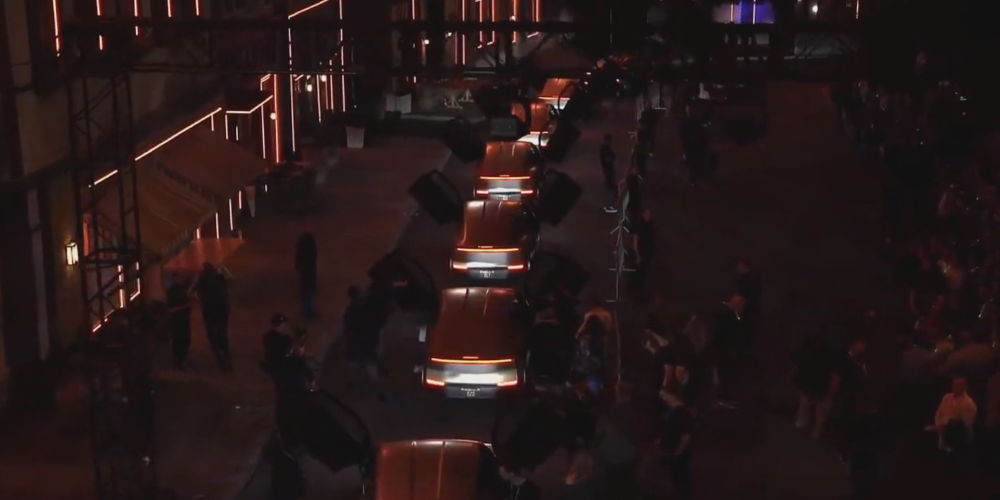
Pony.ai, which is already operational, takes the path of self-developing the "PonyWorld + Virtual Driver" and then achieves breakthroughs through mass production.
The World Model has always been the cornerstone of Pony.ai's R&D efforts, generating over 10 billion miles of simulation data every week to simulate extreme traffic environments such as night, rain, fog, and mixed traffic, supporting large-scale operations. The Virtual Driver, on the other hand, evolves based on the World Model and can also recognize details such as traffic police gestures using mass-produced hardware.
Beyond technology, the true enabler for Robotaxi to take the lead lies precisely in cost, much like DeepMind's counterattack at the time. Tesla's adherence to its current path is driven by cost considerations. However, Chinese Robotaxi players obviously have more favorable conditions in multiple dimensions.
Models require computing power. At the software algorithm level, Pony.ai achieves a 3-fold increase in computing efficiency with the same computing power through deep optimization of neural network operators.
This is equivalent to producing the same product with only one-tenth of Waymo's money. Moreover, the domestic industrial chain advantage has significantly reduced the cost of Robotaxi. For example, the upgrading of domestic LiDAR and other components has brought about tremendous breakthroughs in reducing the cost of Robotaxi. Pony.ai's seventh-generation automotive-grade autonomous driving software and hardware system (Gen 7), exhibited at the 2025 Shanghai Auto Show, will quickly enter mass production. Based on 100% automotive-grade components, it enhances integration efficiency with a modular architecture, shortens the on-board cycle, and reduces BOM costs by 70% compared to the previous generation, significantly improving the economic feasibility of mass production. This "mass production-friendly" cost is something that Waymo cannot achieve.
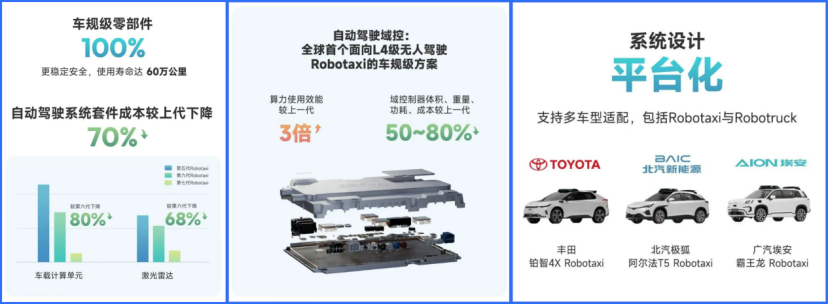
Furthermore, Robotaxi mass production is no longer the independent action of a pure technology company but the deep collaborative cooperation of the entire industrial chain. Pony.ai has partnered with Toyota, BAIC, and GAC Aion for mass production. A diversified cooperation strategy with automakers reduces reliance on a single supply chain while ensuring stable supply of production capacity.
In fact, the transition from the Robotaxi stage to the arrival of the first year of mass production, along with a series of accumulations in technology and the industrial chain, all illustrate a fact: The development of technology companies is more like a marathon, requiring substantial early investment and experimentation, thus forming a "dormant period" characterized by low gross margins or losses, but inevitably crossing the singularity.
In the first quarter, Pony.ai's losses and gross margins still need improvement, with adjusted R&D expenses alone increasing by 38% year-on-year. However, these R&D expenses are incurred due to investments in the seventh-generation Robotaxi and other initiatives. Its scale is a crucial variable in reversing the situation. This set of relationships is the source of the fate of technology enterprises that decline first and then rise.
Perspective on Commercialization: Robotaxi is Fully Entering the Market
With the advantage of mass production, the "first year" also marks an inflection point, with the core being that mass production has commercial applications. This is the fundamental difference between Robotaxi and AI – AI's commercialization is still in "guerrilla warfare," searching for opportunities from multiple angles, while Robotaxi already has a clear path because its commercialization prospects are straightforward to reason out.
Firstly, the entire industry faces the challenge of breaking even. Robotaxi commercialization must consider how to achieve single-vehicle profitability, with the core still being cost. However, in addition to software and hardware costs, operational and monitoring costs must also be considered. Currently, changes are happening simultaneously with the synergistic reduction of software and hardware costs, industrial chain scaling, and the reduction of single-vehicle monitoring costs.
Pony.ai has predicted that it will achieve single-vehicle operational break-even in 2025. Besides software and hardware costs, another factor is the monitoring of 20 Robotaxi vehicles by one remote safety officer, which is also a direct effect of technology. With this support, single-vehicle operating costs will continue to decline, achieving what Peng Jun, co-founder and CEO of Pony.ai, said, "Every vehicle invested in will at least not lose money."
Based on better operational conditions, the fleet will also scale to 1,000 vehicles, achieving a virtuous cycle between scale, gross margin, cost, and user experience. This is the ultimate goal of Robotaxi routine operations.
Secondly, commercialization relies on business models, and various enterprises are advancing platform cooperation and user cultivation simultaneously, exploring different paths. Baidu, Didi, and others focus on their own platforms, while Pony.ai acquires customers through multiple channels such as its own App and third-party platforms (like QiChuxing, Alipay, Gaode Map, etc.).
Multi-channels have their advantages. In the first quarter of 2025, the number of registered users of Pony.ai increased by more than 20% month-on-month, with an average daily order volume exceeding 15 orders. Moreover, in April and May, Pony.ai successively entered into cooperation with Tencent Cloud and Uber. The former corresponds to Tencent's opening of the first-level entry of "Travel Services" and Tencent Map's precise traffic guidance system, bringing a more complete service system. The latter corresponds to stronger internationalization, which means a larger market space.
Finally, Robotaxi application scenarios are expanding from single enclosed areas to diversified open areas. For example, Pony.ai is expanding paid Robotaxi services in first-tier cities, with commercial operations currently covering key transportation hubs such as central urban areas, airports, and high-speed rail stations. The substantive significance lies in covering higher-density markets. Robotaxi will transform from a luxury to a daily travel option, just as AI has swept through the daily lives of ordinary people, ushering in a new era for the industry.
Looking back at this transformation, operational capability is the core bottleneck for the scale and commercialization of Robotaxi, continuously challenging the capabilities of entrants. However, after traversing the path from 0 to 1, the resistance has been greatly reduced. The deployment of thousands of vehicles, verification of single-vehicle profit models, diversification of customer acquisition channels, and expansion of application scenarios have been overcome one by one, further proving that the commercialization inflection point for this $200 billion blue ocean market has arrived. As the "first year of mass production," 2025 will be a crucial year for Robotaxi to transition from concept to reality.
Source: US Stock Research Society



